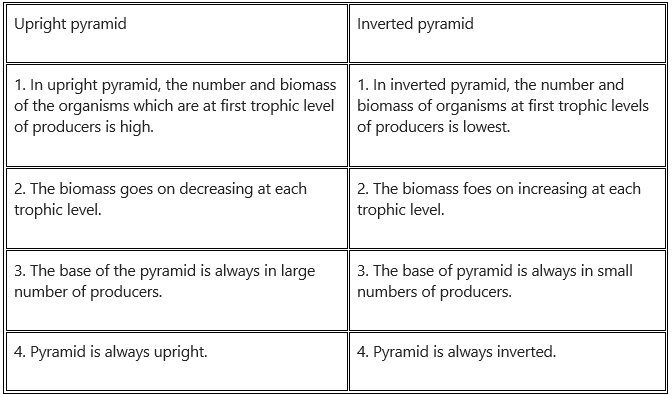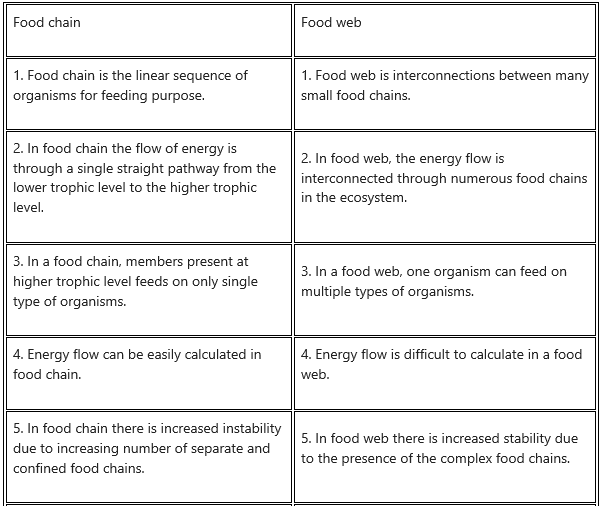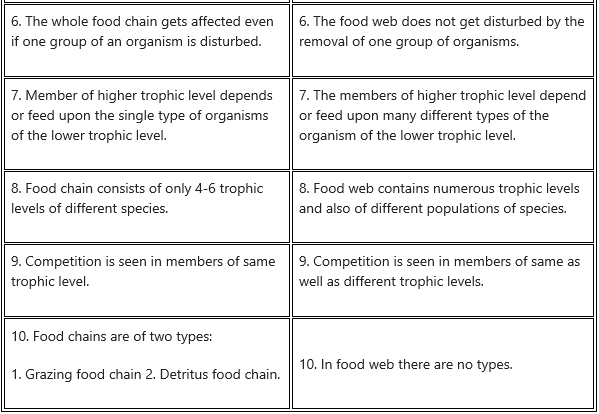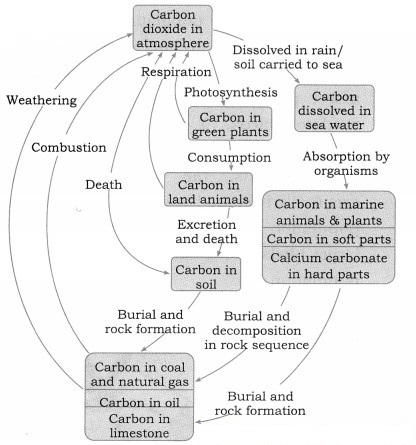Chapter 14 Ecosystems and Energy Flow
1. Multiple choice questions
Question 1.
Which one of the following has the largest population in a food chain?
(a) Producers
(b) Primary consumers
(c) Secondary consumers
(d) Decomposers
Answer:
(a) Producers
Question 2.
The second trophic level in a lake is ……………………
(a) Phytoplankton
(b) Zooplankton
(c) Benthos
(d) Fishes
Answer:
(b) Zooplankton
Question 3.
Secondary consumers are …………………….
(a) Herbivores
(b) Producers
(c) Carnivores
(d) Autotrophs
Answer:
(c) Carnivores
Question 4.
What is the % of photosynthetically active radiation in the incident solar radiation?
(a) 100%
(b) 50%
(c) 1-5%
(d) 2-10%
Answer:
(b) 50%
Question 5.
Give the term used to express a community in its final stage of succession?
(a) End community
(b) Final community
(c) Climax community
(d) Dark community
Answer:
(c) Climax community
Question 6.
After landslide which of the following type of succession occurs?
(a) Primary
(b) Secondary
(c) Tertiary
(d) Climax
Answer:
(a) Primary
Question 7.
Which of the following is most often a limiting factor of the primary productivity in any ecosystem?
(a) Carbon
(b) Nitrogen
(c) Phosphorus
(d) Sulphur
Answer:
(c) Phosphorus
2. Very short answer question.
Question 1.
Give an example of ecosystem which shows inverted pyramid of numbers.
Answer:
Number of insects dependent on a single tree, is an example of ecosystem having inverted pyramid of numbers.
Question 2.
Give an example of ecosystem which shows inverted pyramid of biomass.
Answer:
Oceanic ecosystem has inverted pyramid of biomass.
Question 3.
Which mineral acts as limiting factor for productivity in an aquatic ecosystem?
Answer:
Phosphorus acts as limiting factor for productivity in an aquatic ecosystem.
Question 4.
Name the reservoir and sink of carbon in carbon cycle.
Answer:
Atmosphere is the reservoir of carbon cycle, while fossil fuels embedded in ocean and oceanic waters are the sink of carbon in carbon cycle.
3. Short answer questions.
Question 1.
Upright and inverted pyramid of biomass.
Answer:

Question 2.
Food chain and Food web.
Answer:


4. Long answer questions
Question 1.
Define ecological pyramids and describe with examples, pyramids of number and biomass.
Answer:
1. Ecological Pyramids : Ecological Pyramids are the representation of relationships between different components of ecosystem at successive trophic levels.
2. Pyramid of numbers:
- Pyramid of numbers is the diagrammatic representation which shows the relationship between producers, herbivores and carnivores at successive trophic levels in terms of their numbers.
- As we go up the trophic levels, the interdependent organisms keep on reducing in their numbers.
- For example, the number of grasses are more than the number of herbivores which eat them. The number of herbivores such as rabbits would be lesser than grass but greater than the carnivores that are dependent upon the population of rabbits.
- Thus, the producers would be more than primary consumers and primary consumers would be more than secondary consumers. The top level consumers would be least in their numbers. This pyramid shows upright nature.
3. Pyramid of biomass:
(1) Pyramid of biomass are constructed by taking into consideration the different biomass in every successive trophic level.
(2) Pyramid of biomass in seas in inverted as the biomass of fishes is more than the biomass of phytoplankton.

Question 2.
What is primary productivity? Give brief description of factors that affect primary productivity.
Answer:
(1) Primary Productivity : The rate of generation of biomass in an ecosystem which is expressed in units of mass per unit surface (or volume) per unit time, for instance grams per square metre per day (g/m²/day) is called primary productivity.
(2) Primary productivity is described as gross primary productivity (GPP) and net primary productivity (NPP).
(3) The rate of production of organic matter during photosynthesis is called gross primary productivity of an ecosystem. Of this the amount of energy lost through respiration of plants is called respiratory losses.
(4) Gross primary productivity minus respiratory losses gives the net primary productivity (NPP).
(5) Net primary productivity is the available biomass for the consumption to heterotrophs (herbivores, carnivores and decomposers).
(6) Factors affecting primary productivity: Gross primary productivity (GPP) depends on the following factors:
- Plant species inhabiting a particular area.
- Variety of environmental factors such as temperature, sunlight, salinity, oxygen and carbon dioxide content, etc.
- Availability of nutrients and
- Photosynthetic capacity of plants.
Question 3.
Define decomposition and describe the processes and products of decomposition.
Answer:
- Decomposition is the process carried out by the decomposer organisms.
- Most of the bacteria, actinomycetes and fungi are decomposers. They convert the dead and decaying organic matter into simpler compounds. These simpler inorganic substances return back to the environment.
- Decomposition takes place through detritus food chain. It starts from the dead organic matter. Detritus eating organisms called detritivores like earthworm, etc. breakdown the detritus into smaller fragments. Therefore, this first step of decomposition is called fragmentation.
- Water soluble inorganic nutrients seep into the soil after fragmentation. These nutrients get precipitated as salts. Therefore, this second step of decomposition is called leaching.
- The third step of decomposition is called catabolism. In this step, fungal and bacterial enzymes degrade the detritus into simple inorganic substances.
- The partially decomposed organic matter is called humus which is formed by the process of humification. Humus is a dark coloured amorphous substance which is the reservoir of nutrients.
- Humus too undergoes decomposition by bacterial action at a very slow rate and ultimately releases inorganic matter. This process is therefore called mineralization.
- Decomposition requires oxygen in greater amount. The rate of decomposition is dependent upon the temperature and the humidity of the environment.
Question 4.
Write important features of a sedimentary cycle in an ecosystem.
Answer:
- Reservoir of sedimentary cycles is earth’s crust.
- The nutrients such as phosphorus which show sedimentary cycle, moves through hydrosphere, lithosphere and biosphere.
- There is no respiratory release of nutrients into the atmosphere which show sedimentary cycle.
- Natural reservoir of such nutrients are usually in the form of rocks. The rocks upon weathering release such nutrients into circulation.
- Sedimentary cycles are very slow in their reactions.
Question 5.
Describe carbon cycle and add a note on the impact of human activities on carbon cycle.
Answer:
I. Carbon cycle:
(1) The entire carbon cycle has following basic processes viz. Photosynthesis, Respiration, Decomposition, Sedimentation and Combustion.
(2) Carbon is an important element as it forms 49% of the dry weight of all organisms. 71% of global carbon is present in the oceans. Therefore, ocean is the major reservoir of carbon. Carbon is also present in all fossil fuels. This is long term storage places or sinks for carbon which is in the form of coal, natural gas, etc.
(3) Respiration and photosynthesis are the two events that keep the carbon in cyclic circulation. During respiration, oxygen is used for combustion of carbohydrates as a result of which carbon dioxide and water are formed with the release of energy. The process of photosynthesis utilizes carbon dioxide and water vapour liberating oxygen and producing carbohydrates at the same time.
(4) Solar energy is stored in the carbon-carbon bonds of carbohydrates during photosynthesis whereas respiration releases the same stored energy.
(5) The main reservoirs for carbon dioxide are in the oceans and in rocks. Carbon dioxide is highly soluble in water and forms mild carbonic acid upon dissolving. This dissolved carbon dioxide precipitate as a solid rock or limestone which is calcium carbonate. This reaction in the seas is aided by corals and algae which in turn builds the coral reefs made up of limestone.
(6) Carbon moves through food chains. Autotrophic green plants on land and in water take up carbon dioxide and manufacture carbohydrates by the process of photosynthesis. The carbon stored in plants has three different fates, viz. liberation into atmosphere, consumption by animals upon feeding, storage in the plant till the plant dies.
(7) Animals get their carbon requirement through their food. When autotrophs are consumed, the heterotrophs obtain carbon. Carbon in animals also has three fates, viz. release back into the atmosphere in the process of respiration, release of stored carbon from the body by the action of decomposers or conversion into fossil fuels if buried intact.
(8) Fossil fuels such as coal, oil, natural gas, etc. can be mined and burned for energy purposes. This burning releases carbon dioxide back into the atmosphere.
(9) Carbon from limestone can also be released if pushed to the surfaces and slowly weathered away. Subducting and volcanic eruptions can also release the stored carbon from sediments.

II. Impact of human activities on carbon cycle:
(1) Excessive burning of fossils fuels for power plants, industrial processes and vehicular traffic, adds excessive carbon dioxide into atmosphere. When fossil fuels burn to run factories, power plants, motor vehicles, most of the carbon quickly enters the atmosphere as carbon dioxide gas.
(2) Each year, 5.5 billion tonnes of carbon is released through combustion of fossil fuels. Of this massive amount, 3.3 billion tonnes stays in the atmosphere.
(3) Rapid deforestation also increases carbon dioxide. Since plants absorb carbon dioxide for their photosynthesis, they always reduce the concentration of CO2. But deforestation upsets this balance.
(4) Massive burning of fossil fuel for energy and transport, have significantly increased the rate of release of carbon dioxide into the atmosphere which is causing global warming and resultant climate change.